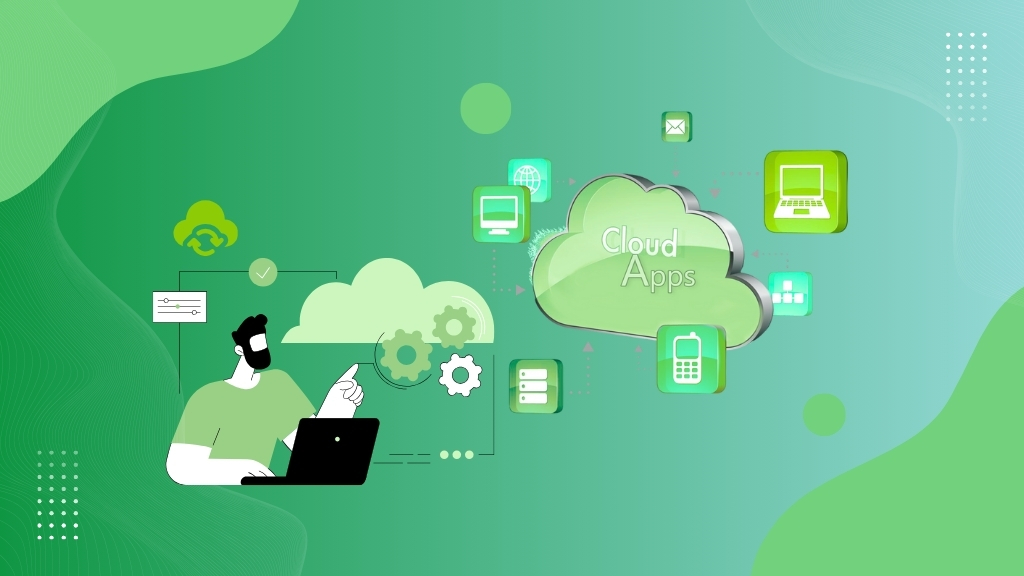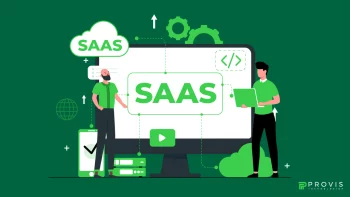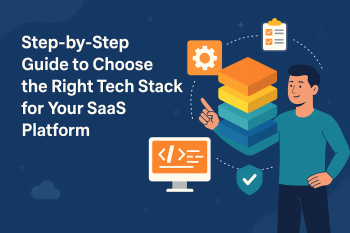What if you get access to the applications from anywhere in the world, with the flexibility to scale your business seamlessly as it grows?
Previously, it was not possible, but today, with cloud-based applications, businesses can manage everything on the cloud without the need for server rooms anymore. According to a report by Statista, 60% of all corporate data is stored in the cloud.
Such adoption gives rise to benefits like scalability, flexibility, and cost reduction, and such a revelation shows that companies from different industries are moving towards cloud-based application adoption.
Here, you will get a step-by-step guide on cloud application development through the process of planning and design through to the official launch and beyond.
What is Cloud Application Development?
Now, before we go into the step-by-step process, we should define what it means to develop cloud-based applications. Cloud application development involves creating software applications that run in the cloud environment by using cloud computing resources such as storage, servers, and databases.
This means they operate not on local hard drives that are within the office but on servers that are located in remote locations. These applications can be accessed over the internet and this allows people to work from anywhere at any time they desire.
Some benefits of the Cloud Application Development are as follows:
- Scalability: Cloud applications can easily scale up or down based on demand, so businesses can handle varied workloads without investing in additional hardware.
- Cost Efficiency: Work on a consumption basis so that there is little call for excessively large upfront costs.
- Accessibility: Given that the applications can be accessed from any location where the internet connection is available.
- Automatic Updates: As mentioned before, frequently, cloud providers take care of applications, software updates, and maintenance.
- Disaster Recovery: Disaster recovery is a well-developed service that includes data protection in the cloud by providers.
Also Read: Custom Education App Development: Cost & Features
Step-by-Step Guide To Cloud-Based Application Development
Step 1 – Planning & Requirement Gathering
Developing and building cloud applications starts with planning when all aspects are well-analyzed and well-thought-out. Within this stage, the problem that is to be solved is understood, the target audience is recognized, and all requirements are gathered.
Identify Objectives
- Define the problem: What is lacking in the market that your app aims to fill?
- Set goals: What is the goal of creating such an app? But is increasing the number of customers increasing productivity, or is it another factor?
- Target Audience: Which users are going to take advantage of using your app? Generally, understanding your users will help you determine what functionality your app should have.
Requirements Gathering
- Functional Requirements: What features should your app have?
- Non-functional Requirements: Think about performance, security, and how well it can grow.
- Technology Stack: Pick the coding languages, frameworks, and databases you’ll use.
Don’t Miss: Top 8 Programming Languages for Mobile App Development
Step 2: Choosing a Cloud Service Provider
Once you come up with a clear plan, you are required to select the CSP to work with to accomplish your cloud application development goal. AWS, Microsoft Azure, Google Cloud Platform, and GCP are the most popular options. They are so different in what they offer, so you should select the one that meets your application requirements.
Things to Think About
- What They Offer: Ensure that the CSP is capable of providing you with all the services that you require, such as databases, storage, and networking services.
- Cost: Options make changes when it comes to the specific price structure of those services.
- Following Rules: Although this is still a basic criterion, one has to ensure that there are rules the CSP has to follow that are relevant to your field or industry.
- Help: See how efficient they are at their support service and the kind of guides that they offer.
Choosing the Right Cloud Model
- Infrastructure as a Service (IaaS): Provides computing resources through the internet: Computes resources are delivered over the internet.
- Platform as a Service (PaaS): Offers the customers a facility to develop, manage, and support apps and they do not have to bother about the support.
- Software as a Service (SaaS): Provides software applications on the web, sometimes with usage on an agreed-fee basis.
Step 3: Creating the Architecture
Creating the architecture plays a key role in cloud-based application development. It involves making a plan for how the app will be organized and how different parts will work together.
Related Blog: A Step-by-Step Guide for FinTech App Design With Expert Tips
Architecture Patterns
- Microservices: Split the app into tiny standalone services that you can deploy and grow on their own.
- Serverless: Puts the spotlight on rolling out functions or small services without having to manage the servers underneath.
- Monolithic: An old-school method where you build the app as one big unified piece.
Design Considerations
- Scalability: Create and build cloud applications design that can handle different workloads without slowing down.
- Security: Put in place strong safeguards, like data scrambling and user checks, to keep information safe.
- Data Management: Work out how to write, read, and manipulate data onto, from, and within the computer. One might think of employing databases big data storage, and rapid data access techniques.
- Integration: Make certain the app can integrate with other systems or, in essence, external services.
Prototyping
It could, therefore, be advisable to think of carrying out a test of the design before even committing to it. In this way, it is possible to see if the proposed cloud-based application development design decisions are effective and to reveal problems.
Step 4: Development
These are the steps taken by developers as soon as the architecture of the system is done. This stage entails coding of setting up of services, as well as aggregation of several components.
Development Process
- Set Up Development Space: Prepare local and cloud environments that are needed to build, test, and launch your application.
- Code Creation: Develop the application about the design and architecture formulated. They should use a version control system like Git or tools of its kind for versioning and multiple authors’ work.
- Link Services: Apply cloud databases, storage, and API to your application.
- Implement CI/CD: Employ pipelines that form the use of continuous integration and delivery to make, check, and launch code.
Security Best Practices
- Authentication & Authorization: Integrate OAuth or SAML to control the handling of the user login and their access rights.
- Data Encryption: Security should be provided to the info being processed as well as when it is in transit as well as when it is in storage.
- API Security: Protect your APIs by putting quotas and rate limits, token validation, and OAuth on your APIs.
Step 5: Testing
However, as important as designing is, testing is equally crucial because it helps to ascertain whether your cloud-based application is functional and meets functional requirements.
Types of Testing
- Unit Testing: Check code sections separately to detect their work.
- Integration Testing: Make sure that the variety of the app fragments is stable and interdependent.
- Performance Testing: Assess the expected behavior of the application in conditions like a large number of users or in the case of dealing with big amounts of data.
- Security Testing: Identify the loopholes that can further affect the app and its resources and cover them.
- User Acceptance Testing (UAT): Collect data from the target market, regarding future users of the app and the demands and expectations to meet.
Automated Testing
Establish good internal test structures to have a form of iteration that simplifies the testing process. Some tools can help with this task and they include Selenium, JUnit, and Jenkins.
Step 6: Deployment
Deployment is the process of moving your app from your computer to the cloud making it available for use by the users.
Deployment Strategies
- Blue-Green Deployment: Creating shadow IT production with two similar settings – working in the green environment while the second is used as the testing one in the blue setting. After some testing, switch traffic to the blue setup.
- Rolling Deployment: Replace hard-coded instances of the old version with new instances.
- Canary Deployment: Test the app to a select audience before it goes out in the market fully.
Monitoring and Logging
- Monitoring: Some aspects influencing tracking performance and resource utilization are connected with the use of cloud-native monitoring tools: AWS CloudWatch, Azure Monitor, etc.
- Logging: The main purpose of this is to log the app events and errors. Applications such as Elasticsearch or even AWS Cloud trail can help with the handling and analyzing of logs.
Step 7: Maintenance and Optimisation
That’s not where it stops because deployment continues. But keeping your app on the cloud, reliable, secure, and highly effective requires constant enhancement and fine-tuning.
Maintenance Tasks
- Regular Updates: Always ensure that the application is equipped with the latest security features and the latest software versions.
- Performance Optimization: Monitor and optimize performance because resources can be fine-tuned to increase performance.
- Bug Fixes: Solve any bugs or problems that pop up after deployment.
Must Know: How to Choose a Mobile App Development Framework: A Beginner’s Guide
Scaling
As more users come on board, your app might need to scale up. Cloud-based application development can scale out (add more instances) or up (boost resources of existing instances).
Cost Management
Keep an eye on cloud usage and cut costs by scaling resources based on real demand using reserved instances or making the most of spot instances.
Conclusion
Creating apps on the cloud will help you get a lot of benefits for your business in the long run. If you stick to this step-by-step guide on cloud application development, you can make apps that grow, save money, and adapt to what your users need.
Every part matters a lot for your app to do well, from planning and designing how it’s built to getting it up and running and keeping it going. As tech keeps moving forward, staying in the loop with what’s new and what works best in cloud computing will help you stay ahead of others in the market.
Written By
Author's Picks
- 20 Best Free Live Streaming Apps
- 23/11/2024
- Fixed vs. Hourly Pricing Models: Choosing the Right Strategy for Your App Development Cost
- 28/08/2024
- How to Build an App Like Uber: A Comprehensive Guide
- 10/09/2024
Categories
- AI for Startups
- AI in Web Development
- AI Integration
- AI Platforms
- AI Prompt
- AI Tools
- AI Trading Software
- Android App
- Android vs iOS Development
- Angular
- API
- API Development
- App
- app development
- App Idea
- App User Feedback
- Application
- Artificial Intelligence
- Audit Services
- Automotive Industry
- Awards and Recognition
- Business Consulting
- Business Website
- Chatbots
- CRM
- CRM for Financial Advisors
- Custom CRM
- Custom SaaS
- Custom Website
- Customer Service
- dashboard design
- Developing a Mobile App
- Digital Business
- E-commerce
- EMR Integration
- Finance
- Financial Advisors
- Financial Advisors
- GIT
- Health Insurance
- iOS App
- iOS App Development
- IoT Mobile App Development
- IoT Platforms
- IT Audit Services
- IT Consulting
- IT Strategies
- Java Development
- Laravel
- Lean Canvas
- Learning Management System
- Logistics Apps
- Mobile App Development
- MVP
- Native App
- News Aggregator Site
- OTT
- Outsourcing IT
- Payment Gateway
- predictive analysis
- Product Launch Strategy
- Progressive Web App (PWA)
- Prototype
- Recommender Systems
- Ruby
- SaaS
- SaaS Application
- SaaS Business
- SaaS Company
- SaaS Development
- SaaS Product
- SaaS Project
- Sales Funnel
- SEO
- Shopping Cart
- Software Development
- SSL and TLS
- Startup Checklist
- Technology
- Tetradic Color Scheme
- UI/UX Design Company
- Unit Testing
- User Flow
- User Testing
- Web Development
- Web Performance Optimization
- website Maintenance Services
- Website Migration Service
- Website Speed Optimization
- WooCommerce
- WordPress





